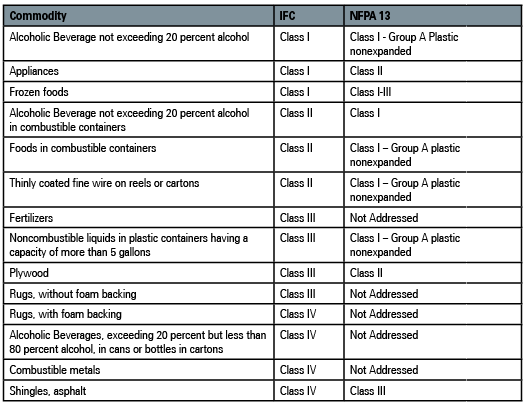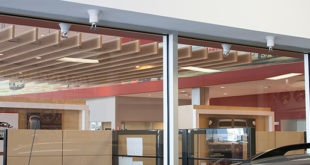The Fire Code and NFPA 13 Standard Don’t Match Up
The International Fire Code (IFC), 2015 edition and NFPA 13, Standard for the Installation of Sprinkler Systems, 2016 edition have different lists for classifications of commodities. When the two differ, which one do you apply? This could place you in a dilemma between you and the fire official or Authority Having Jurisdiction (AHJ). Let’s look at some of those differences and hopefully this provides some guidance if you find yourself in this situation.
Figure 1 shows a partial list of some commodities from the IFC that differs from the NFPA 13 standard. The list is an example and is not all inclusive of all the differences in commodity classifications. Some commodities are well aligned between the IFC and the NFPA 13 standard and were not noted in Figure 1. Some commodities are listed in Chapter 32 of the IFC and are not specifically referenced in NFPA 13 and vice versa. Examples are ceramics, light bulbs, biomass briquettes or pellets, paints, feed, corn cobs, combustible metal products, etc. When applying the commodity class per NFPA 13, the makeup of the product or storage determines the commodity class based on judgment. The classification of plastics (Group A, B, or C) between the IFC and NFPA 13 are pretty well aligned with some minor differences.
The approach in using the IFC is different from the approach in the NFPA 13 standard. There are many more aspects for fire protection and life safety to consider when applying the IFC. The NFPA 13 standard considers the sprinkler protection by indicating the discharge criteria to be applied for the stored commodity and how the system is to be installed. Chapter 32 High-Piled Combustible Storage in the IFC addresses other issues besides sprinkler protection. These include fire department apparatus access, building access, sprinkler protection, standpipes for exit access, fire detection and alarms, fire extinguishers, smoke and heat vents, etc. The IFC references high-piled storage so it needs to have some listing of commodities and this is provided in Section 3203 Commodity Classification. Note that the IFC requires sprinklers for the storage occupancy, but there is no discharge criteria noted for high-piled storage. As such, the IFC is requiring protection and leaving the discharge criteria to the NFPA 13 standard.

The IFC provides a commodity list in Section 3203 since the code references Class I-IV and high-hazard commodities in other areas of the code. This allows the user to make reference to the commodity in the application of the code. The rub comes into play when commodity descriptions don’t match. A code requirement will trump a standard requirement when considering the hierarchy of application. The IFC addresses this in Section 102.7 Referenced Codes and Standards. The codes and standards referenced in this code are listed in Chapter 80 shall be considered to be part of the requirements of this code. This makes the standard part of the code. This is followed by Section 102.7.1 Conflicts, where it says the provisions of this code apply when conflicts occur between provisions of this code and referenced codes and standards. This is also followed by Section 102.7.2 Provisions in Referenced Codes and Standards, stating the IFC shall take precedence over the provisions in the referenced code or standard. Thus, the code takes precedence over the installation standard in the application of the IFC.
On the other hand, when the NFPA 13 standard does not indicate the commodity class of a product but the IFC does, at least there is some guidance on the commodity class. The issue of the IFC commodity class overriding the commodity class of the NFPA 13 standard could result in inadequate protection. The discharge from the sprinkler systems has to be based on the commodity classes from the NFPA 13 standard for adequate protection. The IFC expects that since there is no discharge criteria provided in Chapter 32.
Let’s provide an example of a conflict in the commodity classification such as frozen foods. Figure 1 on page 27 shows the commodity class from the IFC is Class I and the NFPA 13 standard shows Class I-III. The Conflicts section above says to use the commodity classification from the IFC. This makes a huge difference in the application of a frozen foods warehouse regarding smoke and heat vents. Table 3206.2 indicates for high-piled storage over 2,501 ft2 can require smoke and heat vents and Section 3206.7 refers to Section 910 in the IFC. This says in Section 910.2 that where required, smoke and heat vents or a mechanical smoke removal system shall be installed. The exception is frozen food warehouses used solely for storage of Class I and II commodities where protected by an approved automatic sprinkler system. If the clarification regarding conflicts were not present in the IFC, the commodity class from the annex material within NFPA 13 would try to be applied. If the IFC allowed NFPA 13 to dictate the commodity class, this would result in smoke and heat vents to be required for the frozen foods warehouse. That would be problematic and also not the intent of the IFC. So, it makes sense that the IFC is calling out commodities so the other requirements of the code are applied correctly.
The IFC also refers to commodities as high hazard. There are no such references to high hazard with regard to commodities in the NFPA 13 standard. The IFC defines in Chapter 2 high-piled combustible storage and references high-hazard commodities. The definition says that high-piled combustible storage also includes certain high-hazard commodities, such as rubber tires, Group A plastics, flammable liquids, idle pallets and similar commodities, where the top of storage is greater than 6 ft in height. We see in the NFPA 13 standard that it addresses these high-hazard commodities as individual storage chapters or separate codes and standards referenced in Chapter 22 Special Occupancy Requirements.
An important concept to note in the IFC is that high-hazard commodities are not to be confused with high-hazard occupancy Group H. The term high hazard used in the context of the IFC describes storage commodities that can present high-challenge fires. Some of the commodities listed may result in a Group H occupancy classification whereas others would not.
Flame retardants can also affect commodity classification and are addressed by both the IFC and NFPA 13. The IFC acknowledges in Section 3203.1 that the use of flame-retarding modifiers or the physical form of the material could change the classification and refers to Section 3203.7 for classification of Group A, B and C plastics. The NFPA 13 standard has similar wording in the annex of A.5.6.4. It says the categories listed in Sections 5.6.4.1, 5.6.4.2, and 5.6.4.3 are based on unmodified plastic materials. The use of fire- or flame-retarding modifiers or the physical form of the material could change the classification. The annex material explains that the addition of fire retardants to plastic should not be relied upon as the sole basis for a reduction in classification given the unknown performance of the fire retardant under a storage scenario. It is expected that full-scale or commodity classification type testing would be necessary to justify any such reduction in classification. No reduction in classification should be given for plastics simply because they contain a fire retardant.
The Consumer Product Safety Commission has been involved in the reduction of fire spread involving mattresses and furniture. There is resistance from involved groups that these chemical retardants could be harmful to humans. There is a push to remove the chemical retardants from household commodities. Thus, don’t rely on the fact that mattresses and furniture are all considered fire retardant and reduce the commodity classification.
There is also a great article in June 2015 edition of Sprinkler Age titled, “The Shortcomings of Engineering Judgment, Lessons Learned with Full-Scale Fire Tests on Mattresses” written by Steven Scandaliato. The article addressed full-scale fire testing of plastic covered mattresses by stating: “Not only did the plastic sleeve not burn off as quickly as we thought, but the retardant material was of no value either. And the sprinklers? Well, other than the water on the floor, there was no evidence that they were a part of the test. Everything we thought would happen did not. Apparently, we set a record for the hottest, fastest fire recorded inside that test lab. The fire peaked at 25 megawatts. (For those not familiar with these units, let’s just say it was 15 units higher than the hood we were testing under is rated for and the boss was not happy.)”
The use of plastic pallets will affect commodity classification. The NFPA 13 standard addresses this in Section 5.6.2 where the commodity may have to be increased one class for unreinforced plastic pallets or two classes for reinforced plastic pallets. The IFC addresses this in Section 3206.4.1 Pallets, and refers to the NFPA 13 standard for the presence of pallets. Thus apply the increase in commodity classes per the NFPA 13 standard for plastic pallets. Both the IFC and the NFPA 13 standard allow for plastic pallets to be considered as wood pallets if listed as such. Section 3206.4.1.1 Plastic pallets, allows for listed and labeled in accordance with UL 2335 or FM 4996 shall be treated as wood pallets for determining required sprinkler protection. The NFPA 13 standard allows non-wood pallets that have demonstrated a fire hazard that is equal to or less than wood pallets and are listed as such. The testing standards between Underwriters Laboratories (UL) and FM Global are not equal. FM Global claims its testing is more rigorous than UL’s. An FM Global client may not be allowed to take credit for UL-listed non-wood pallet. Also, some plastic manufacturers make plastic pallets that are listed and not listed. Further verification may be needed on the types of pallets in the warehouse when the listed plastic pallets or non-wood pallets are claimed on the owner’s certificate for sprinkler design.
Lastly, both the IFC and the NFPA 13 standard have figures to classify plastics as a commodity and they differ. The figures are used to determine the commodity classification of a mixed commodity in a package or carton or on a pallet when plastics are involved. The NFPA 13 standard will not allow a plastic involved in a commodity less than Class III whereas the IFC indicates as a Class I, II, or III commodity. Group A is the highest commodity classification in the NFPA 13 standard where the IFC refers to plastic as high-hazard commodity. The NFPA 13 standard now has two figures, one for plastics in cartons, boxes, or crates, and the other for exposed commodities (no packaging material). High-hazard commodity means nothing when trying to determine discharge criteria from the IFC.
In closing, there are times when the IFC and NFPA 13 will identify the same product as different commodity classifications. When addressing the fire protection requirements for the building, use the definitions from the IFC. When addressing the design basis for the sprinkler system, use those from NFPA 13.
 Tom Wellen, P.E., is senior engineer in AFSA’s Technical Services Department. He holds a bachelor of science degree in Engineering Technology, Fire Protection and Safety Technology from Oklahoma State University in Stillwater, and is actively involved with NFPA and SFPE. He has over 20 years of designing, testing, reviewing, and engineering experience. He is a registered fire protection engineer in California and Texas. Wellen serves on committees for the NFPA 13, NFPA 14, NFPA 20, and NFPA 101 standards.
Tom Wellen, P.E., is senior engineer in AFSA’s Technical Services Department. He holds a bachelor of science degree in Engineering Technology, Fire Protection and Safety Technology from Oklahoma State University in Stillwater, and is actively involved with NFPA and SFPE. He has over 20 years of designing, testing, reviewing, and engineering experience. He is a registered fire protection engineer in California and Texas. Wellen serves on committees for the NFPA 13, NFPA 14, NFPA 20, and NFPA 101 standards.
IMPORTANT NOTICE: This article and its content are not a Formal Interpretation issued pursuant to NFPA Regulations. Any opinion expressed is the personal opinion of the author and presenter and does not necessarily present the official position of the NFPA and its Technical Committee.
 Sprinkler Age A Publication of the American Fire Sprinkler Association
Sprinkler Age A Publication of the American Fire Sprinkler Association


Haha this saves me a lot of time, really simple to use just install and follow the instructions. Get items instantly or level up your character with a click of a button.
hermes kelly 35 handbags fake for women http://www.accessoires-mode.in/hermes-handbags-kelly-35-cm-beige-cowskin-leather-gold-hardware-bag-p316/